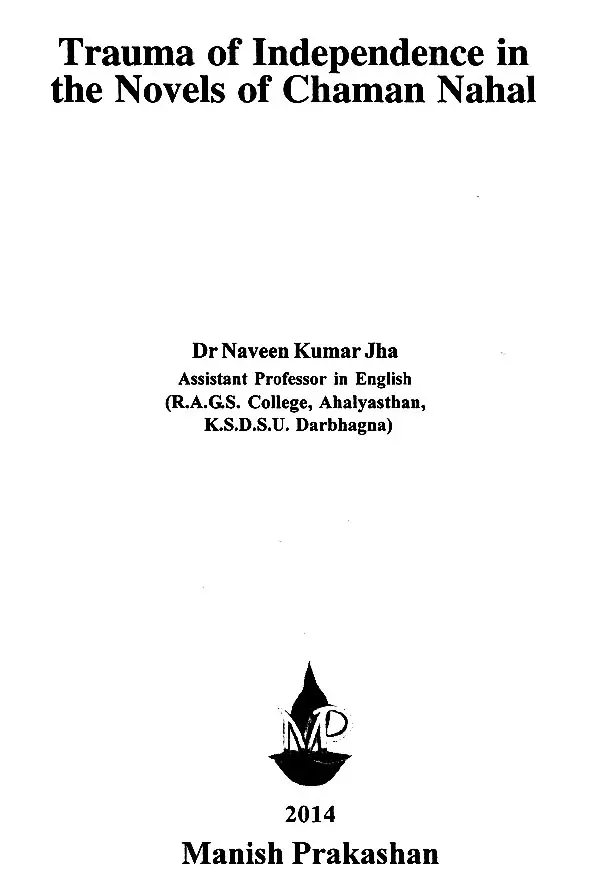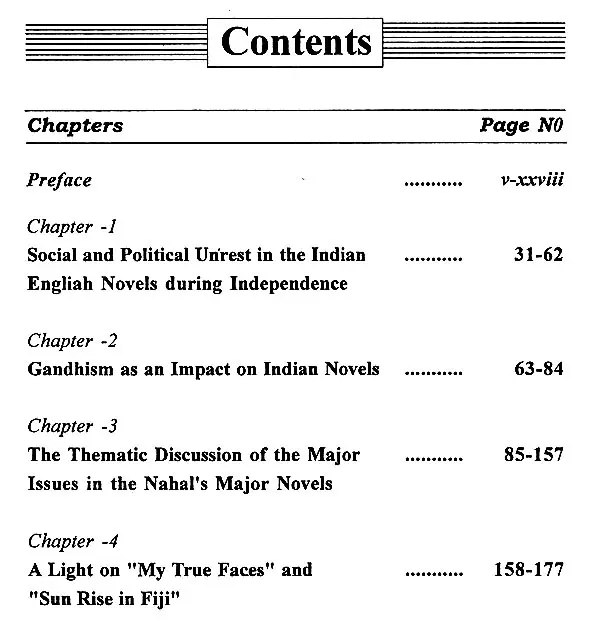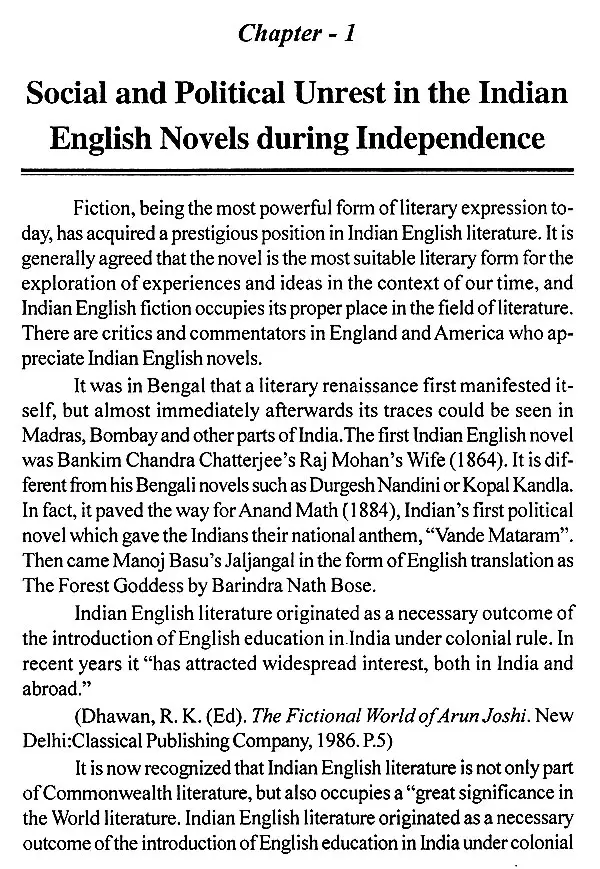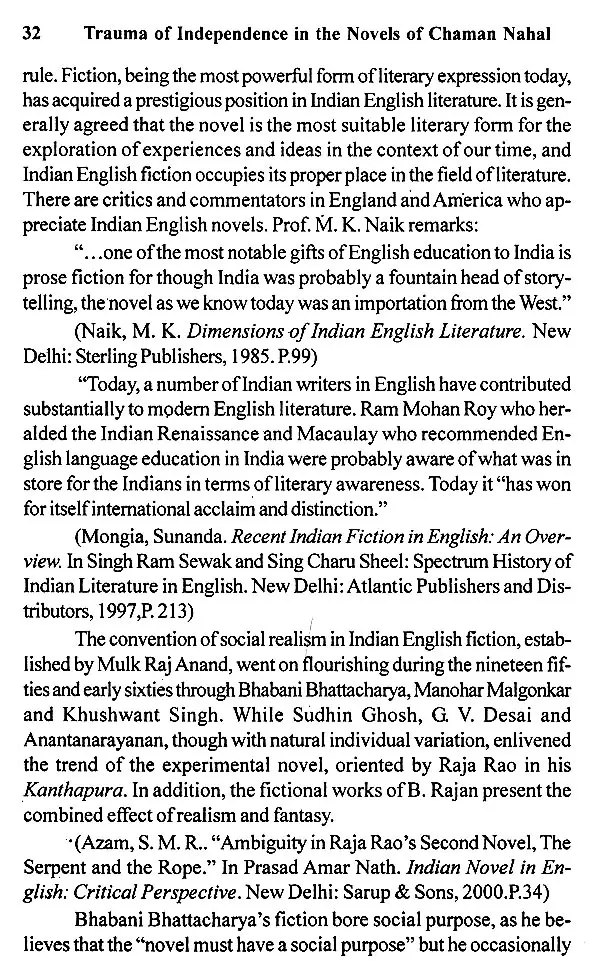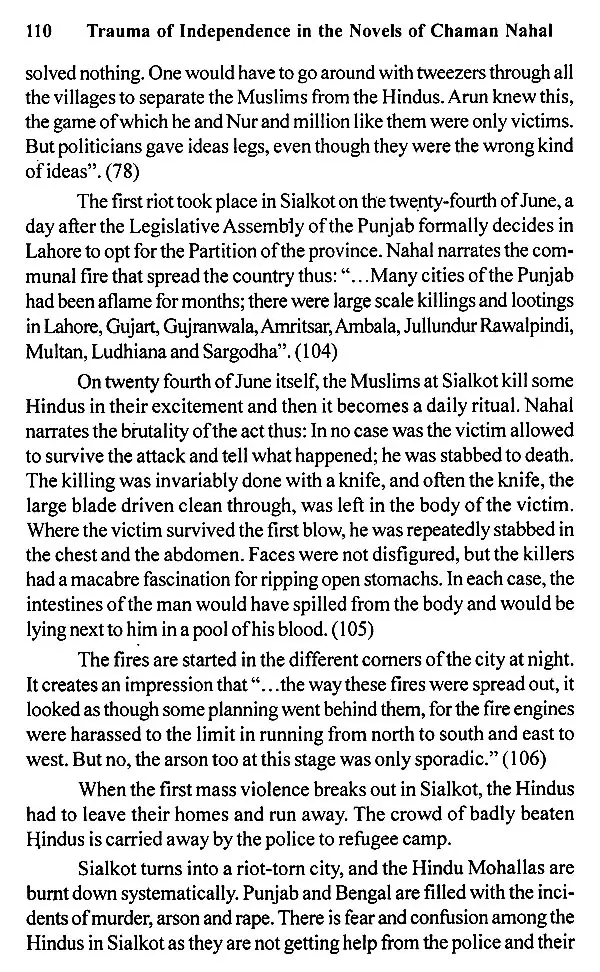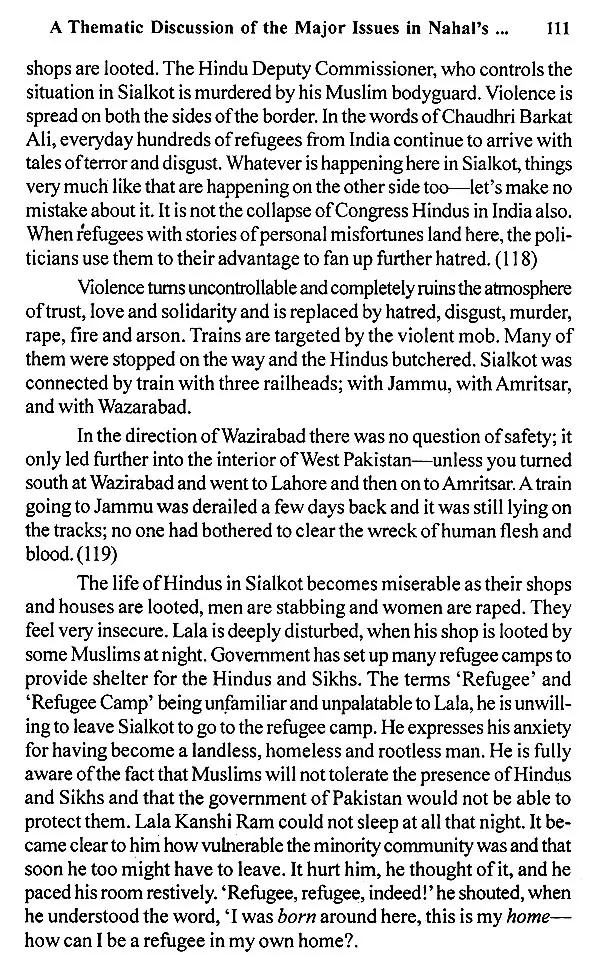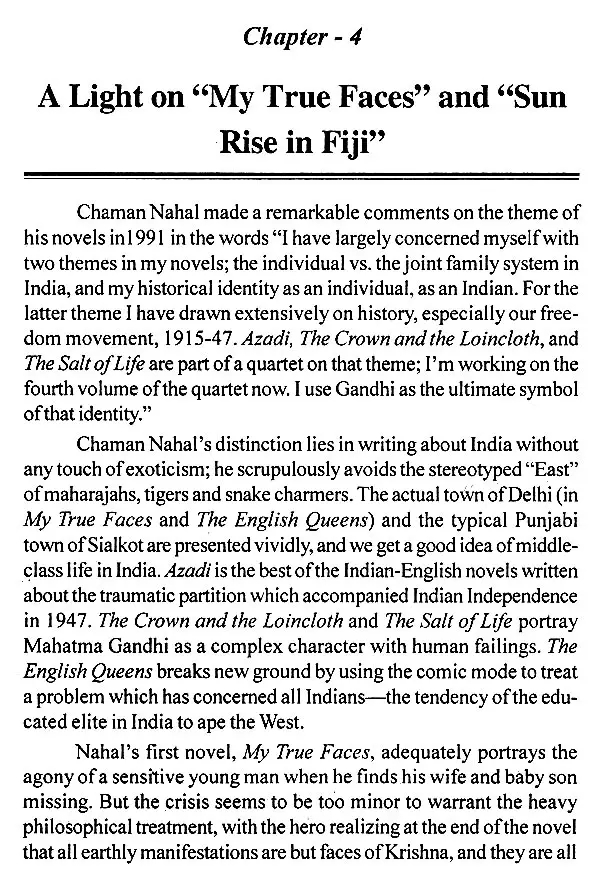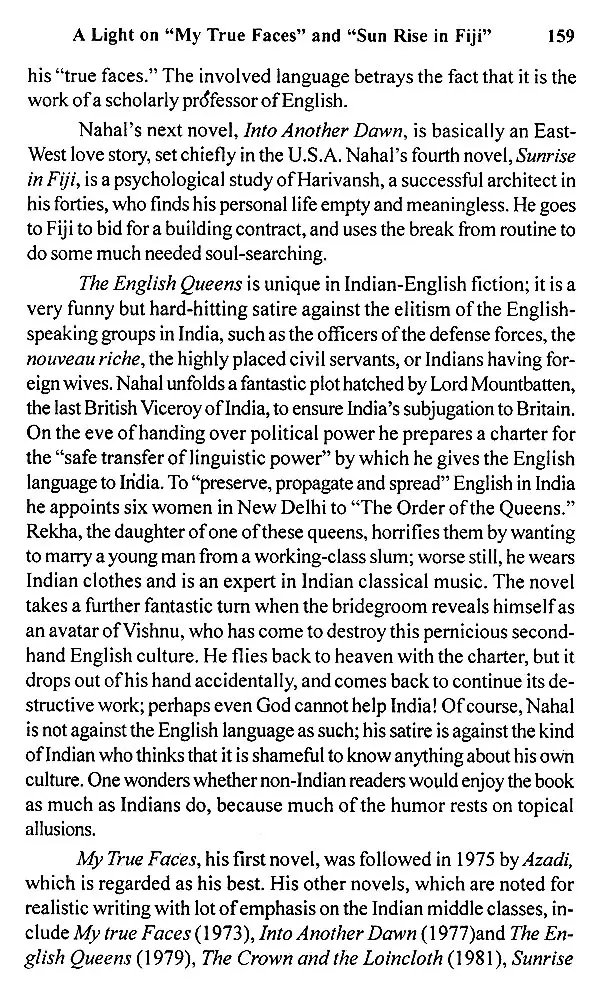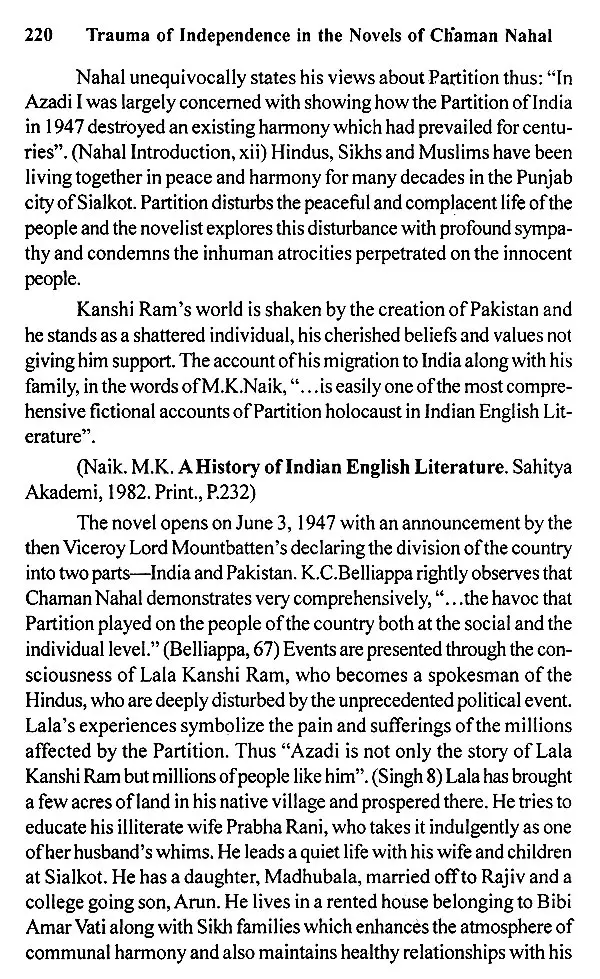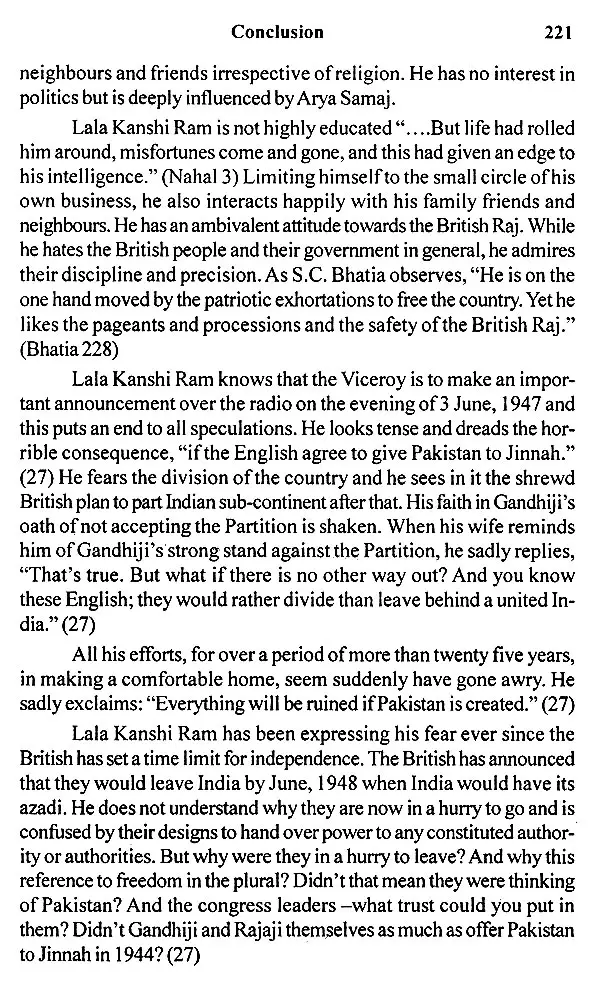
Trauma of Independence in the Novels of Chaman Nahal
Book Specification
| Item Code: | UAG176 |
| Author: | Naveen Kumar Jha |
| Publisher: | Manish Prakashan, Varanasi |
| Language: | English |
| Edition: | 2014 |
| ISBN: | 9789381539996 |
| Pages: | 231 |
| Cover: | HARDCOVER |
| Other Details | 9.00 X 6.00 inch |
| Weight | 410 gm |
Book Description
The book named "Trauma of Independence in the Novels of Chaman Nahal" is a critical analysis of the major novels including "My True Faces" in 1973, "The Sun Rise in Fiji" in 1988, "Azadi" in 1975. "Into Another Dawn" in 1977, "The crown and Loincloth" in 1981, "The Salt of Life" in 1991 and "The Triumph of the Tricolor" in 1993 by a noted Indian English novelist during post-independence. Chaman Nahal is one of the outstanding novelists of the seventies (1970's). He wrote eight novels out of which four constitute of Gandhi quarter Azadi is an Epilogue to the whole Quart. During partition of Indian there was a flight of Hindu Family from Sialkot to Delhi. In that political catastrophic situation the love story of a Hindu boy to a Muslim girl unfolds against sense of terror and violence. The division of the novel into three parts "Lull", "Storm" and "Aftermath" makes it clear that the novel is about horrible incidents and pitiable conditions silently growing into the womb of independence.
The novels of Chaman Nahal are of historical and political significance. Those are great works of art. His novels light on Psychological and cultural upset and, in result, whole rhythm of lie was disturbed. Being a creative writer, he illustrates horror of partition through the life of Lala Kashi Ram of Sialkot. He brings out. positives and negatives of a politically complicated problem. Lala Kashi Ram becomes a spokesperson of Hindus who faced unprecedented political events. The peaceful life of people of Sialkot is disturbed and the Hindu-Muslim unity is fractured due to announcement of partition in the light of Mountbatten plan.
The present book has been divided into six chapters, the first chapter being "Social and Political Unrest in the Indian English Novels during Independence", the second chapter being "Gandhism as an Impact on Indian Novels", the third chapter being "The Thematic Discussion of the Major Issues in the Nahal's Major Novels", the fourth chapter being "A Light on "My True Faces" and "Sun Rise in Fiji", The fifth chapter being "Characterization and Fictional Strategy in Chaman Nahal's Novels" and the last and seventh chapter being "Conclusion". The work takes into account both thematic and strategic perspective of the author which made him such a great historical and political commentator through his novels. Chaman nihal is concerned with individual vs. joint family. system in India and historical identity of an individual as an Indian.
Dr. Naveen Kumar Jha is a well-know academician and a reputed pedagogue. His book entitled "Criticism on Imitation, Creation, Allegory, Morality and Delight" has been lately acclaimed as an illustractive work on English literary criticism. His master piece, "Translation as a technique to Learn English", has proved a recipe for the students belonging to non-English background interested in learning English He has been a versatile poct writing in Maithili, Hindi and English His Hindi Short story entitled "Khuli Anakhein" containing seven short stories has already got its claim among Hindi readers especially at janakpurdham, Nepal His English poems have been published in several English journals. His Maithili poems and essays have been widely published and read both janakpurdham, Nepal and India.
Being a prolific writer he has been subscribing with his English articles to many issues of English journals. His "School Essay Composition" has been published by Himalayan Books Pvt. Ltd Bag Bazar, Kathmandu. A few collections of poems are to be brought out very soon. A cassette of Maithili songs composed (music and lyrics) and sung by the author are to be released within few months. His "Examination Digest to Compulsory English" for grade XI and first year I.A., I.Sc., L.Com, L.Ed. came out in 2002 as a clinical investigation of examination phobia for the students in Nepal.
He is a promising personality and his career as a writer looks to be upstanding. He is an MA in linguistics from Jawaharlal Nehru University, New Delhi. As a teacher he was warmly received at R.R.M. Campus, Janakpurdham, Nepal as well as at Darbhanga. He still holds a charming command on his students for his novelty of teaching technique and approach. He has been a debater in his students life being endowed with several awards by Debating Society of B.N. College Patna, Patna University. He was ranked third in an essay competition held by Pratiyogita Darpan published form Agra.
His interest in dramatic activity and music has made his presence felt at All India English Teacher's Conference and other auspicious occasion. No doubt, he is a man of prodigious potentiality. His latest book captioned "Translation as a Technique to Learn English" will prove a relief for English learners. I invite the learners to begin learn English with this book, most of the hurdles will be overcome. To think that "I can" is panacea to your linguistic bottlenecks, so take a stride into the book with the belief quoted above, you get endowed with linguistic competence and linguistic performance.
Currently, he teaches English at R.A.G.S. College, Ahalyasthan, a constituent unit of K.S.D.S.U., Darbhanga.
Chaman Nahal, born in 1927 in Sialkot, India (now in Pakistan) and educated at Delhi University (M.A., 1948) and the University of Nottingham, England (Ph.D., 1961), was a professor of English at the Institute of Postgraduate Studies, Delhi University, and at Long Island University, New York, USA (from 1968-70). Between 1966 and 1973 he wrote a literary column for The Indian Express.
Nahal's fictions include My True Faces (1973), Azadi (1975), Into Another Dawn (1977), The English Queens (1979), The Crown and Loincloth (1981), Sunrise in Fiji (1988), The Salt of Life (1991) and The Triumph of the Tricolor (1993), and the short-story collection The weird Dance (1965). His critical works include D.H.Lawrence: An Eastern View (1970), The Narrative Pattern in Ernest Hemingwasy's Fiction (1971), and The New Literatures in English (1985).
Critics are in general agreement that Azadi which won the Sahitya Akademi Award and the Federation of Indian Publishers' Award for excellence in 1977 is Nahal's best novel. It was while writing Azadi that he became aware of the potentiality of an historical novel. In the novel he used history as a metaphor.
Chaman Nahal is one of the outstanding novelists of the 1970's. He wrote eight novels. Azadi is one of the four novels which constitute the Gandhi Quartet (Gandhian Ideology). It is a modern classic which presents a comprehensive vision of life demonstrating the havoc that partition played on the people of the country both at the social individual levels. It depicts the realistic historical record of the horrible incidents caused by the partition through literary perspective.
It deals with the theme of partition of Indian subcontinent into India and Pakistan. As Chaman Nahal himself was a refugee, he writes with remarkable penetration and realism.
Indian English fiction, which made a rather diffident appearance in the beginning of the twentieth century, gradually gained momentum and status. Freedom struggle gave a fillip to the Indian English novel and many novelists evinced keen interest in depicting the deepening mood of nationalism, patriotic fervor and reformatory zeal of social reformers. It is a matter of surprise to know that hardly half a dozen novels were written before 1920s and a few more before independence. The close of the Second World War in 1945 brought a harvest of new writers who changed the whole picture of Indian English literatures as it existed before 1947.
Attainment of independence for India on 15th August 1947 marks the end of the nearly two centuries of British rule. No doubt, this was an achievement for the Indian people who had waged a long drawn struggle for freedom against the British Empire. However, India's independence was accompanied by the Hindu-Muslim holocaust. Thus the pride of achievement was marred by much pain and suffering. Just on the eve of independence India was divided into India and Pakistan causing a great upheaval in the whole continent. It brought, in its wake, one of the bloodiest carnages in the history of India. It is not at all surprising that this bloodiest upheaval in history that claimed innumerable innocent lives and loss of property produced great impact on the minds of all the people of the sub-continent. Indian writers who choose to express their creative impulse through novels in English were no exception.
Literature describing the human cost of independence and partition comprises Khushwant Singh's Train to Pakistan (1956), several short stories such as Toba Tek Singh (1955) by Saadat Hassan Manto, Urdu poems such as Subh-e-Azadi (Freedom's Dawn, 1947) by Faiz Ahmad Faiz, Bhisham Sahni's Tamas (1974), Manohar Malgonkar's A Bend in the Ganges (1965), and Bapsi Sidhwa's Ice-Candy Man (1988).
While some creations depicted the massacres during the refugee migration, others concentrated on the aftermath of the partition in terms of difficulties faced by the refugees in both side of the border. Even now, more than 60 years after the partition, works of fiction and films are made that relate to the events of partition.
**Contents and Sample Pages**
